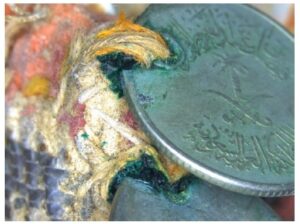June ’20
June’s Object of the Month is a Saudi Veil, which forms part of the collections at the Oriental Museum in Durham.
Object

This object a traditional veil worn by the women of the Harb tribe of Saudi Arabia in accordance with Muslim religious stipulations for women to cover their faces in the presence of men. It is a complex object composed of multiple layers of textiles and embellishments.
The Islamic tribe of Harb is one of the largest cultural tribes in Saudi Arabia, historically living in and around the Western Hijaz region. Traditionally nomadic Bedouins whose lives centred around herding sheep, goats, and camels, they have been moving towards permanent settlement in larger towns and cities since the mid-twentieth century.

Historically, their clothing needed to provide protection from an open desert environment, convey social and family standing, and fulfil the religious requirements of Islam. A veil would not only preserve religious modesty, but protect the face from sun, wind, and sand. Veil styles from this region vary, though their general characteristics are quite similar. This object is most similar to examples from mid-1950’s.
It is not clear whether this veil was for daily use or reserved for important occasions, however it is of a more ‘traditional’ style, meaning ‘something older or related to a heritage style, and alluding to a specific role in modern Saudi society that recalls a nostalgic version of the recent past’. In modern times, many women choose simpler, more comfortable veils for everyday wear. This reveals an important intrinsic value of the object as both a garment used in religious observance and a visual artefact which preserves a declining Saudi way of life.
Condition
- Evidence of dirt on the surface of the veil
- Signs of corrosion on all metal components
- There appears to be a number of areas suffering from surface material loss
- Evidence of ingrained dirt and staining on the textile
- Signs of excess leather dressing.
Conservation

Before the object could be treated it required removal from the case and backing it was attached to as it wasn’t clear the extent of the condition or if the case and display were contributing to its deterioration.
The biggest threat to the veil’s stability was the copper soap corrosion found beneath all coins on the centre strip. The bulk of the copper soap corrosion was first removed mechanically using wooden tools to avoid scratching the metal. Cotton swabs dampened with a solution of 9:1 white spirit : ethanol were used to gently remove the corrosion from the coins, while avoiding contact with threads as much as possible to avoid solvent wicking into them.

During mechanical removal, it became evident that many of the threads securing the coins in place were severely damaged by the copper soap corrosion. Several other areas were also determined to need stitched support. A curved needle was used to stitch beneath and between fabric layers in a non-damaging way, using all original stitch holes where possible.
The veil was cleaned using a vacuum with HEPA filter on low power with fine netting over the nozzle to catch any pieces which became detached. A soft brush was used to dislodge the surface dust toward the vacuum where it could be removed without redeposition.

Cleaning of the copper embellishments was determined necessary for reducing further deterioration and for aesthetics. A solution of 9:1 white spirit:ethanol was used with cotton wool swabs to remove dirt and corrosion. The silver threads and pewter beads were not solvent cleaned due to their stable appearance.
Dampened swabs of white spirit were quickly rolled over the surface of the leather straps to remove excess leather dressing, while also preventing saturation of the leather.

Coatings were considered for all metal embellishments, however the decision was made to not coat any metals. The strongest factor in this decision was the inability to achieve an even coating and there was no guarantee the threads wouldn’t also end up being coated, which was not desired.
Finally a new display mount was created using conservation grade materials, which could also act as a storage mount. This would ensure the object was displayed safely while on display at the Oriental Museum.
Stay tuned for next month’s object!
